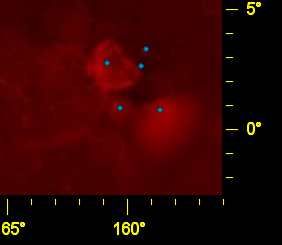
Hover your mouse over each blue dot for the name of the object, or click on the dot for a detail page. This map was created using the all-sky hydrogen-alpha map produced by Douglas Finkbeiner from data collected by the WHAM, VTSS and SHASSA hydrogen-alpha surveys.
The outer galaxy objects east of Camelopardalis are not concentrated in a single complex like the Cassiopeia arc west of Camelopardalis. Instead they appear to be spread out over a wide range of distances.
The first objects to appear east of Camelopardalis are the supernova remnant SNR 160.4+02.8 (Sh 2-221) at an unknown distance, and the planetary nebula PK 158+00 1 (Sh 2-216), which has a large extent in the sky and a distance of only 120 parsecs, making it one of the largest and oldest planetary nebulae known. In between in this image is BFS 44 which has clearly visible nebulosity apparently located at a distance of 6100 parsecs, although almost nothing has been published about this object.
Two smaller nebulae appear to the right of Sh 2-221 in this image: Sh 2-217 is embedded in a 4100 solar mass molecular cloud at 5200 parsecs and Sh 2-119 is an HII region ionised by a B0 V star at a distance of 4200 parsecs.
